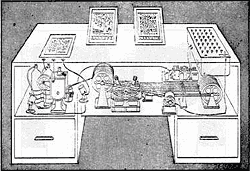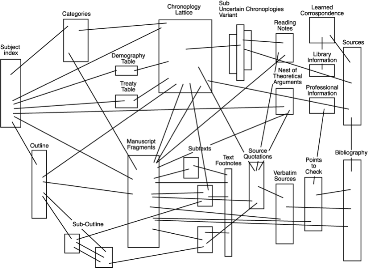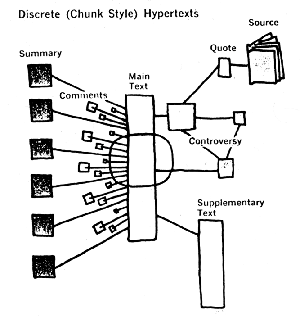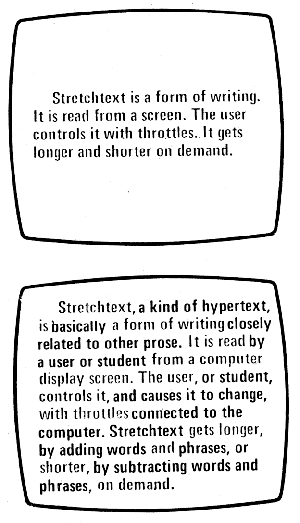Vannevar
Bush, "As We May Think," Atlantic Monthly
(1945)
40s
and 50s: transition from modernism to postmodernism
Problems
of information storage and retrieval: “publication
has been extended far beyond our present ability to
make real use of the record...“[a record] must
be stored, and above all it must be consulted"
Memex
Vision: "a device in which an individual stores
all his books, records, and communications, and which
is mechanized so that it may be consulted with exceeding
speed and flexibility"
Structure
of the memex: desk with two screen monitors and scanner
surface, storage space with graphic and textual information

User
establishes trails to connect information: "When
the user is building a trail, he names it, inserts
the name in his code book, and taps it out on his
keyboard. Before him are the two items to be joined,
projected onto adjacent viewing positions. At the
bottom of each there are a number of blank code spaces,
and a pointer is set to indicate one of these on each
item. The user taps a single key, and the items are
permanently joined"
Results,
I: "...when numerous items have been thus joined
together to form a trail, they can be reviewed in
turn, rapidly or slowly, by deflecting a lever like
that used for turning the pages of a book. It is exactly
as though the physical items had been gathered together
from widely separated sources and bound together to
form a new book."
Results,
II: “Wholly new encyclopedias will appear, ready-made
with a mesh of associative trails running through
them, ready to be dropped into the memex and there
amplified”
Workers: “There is a new profession of trailblazers,
those who find delight in the task of establishing
useful trails through the enormous mass of the common
record. The inheritance of the master becomes, not
only his additions to the world’s record, but
for his disciples the entire scaffolding by which
they were erected”
Ted
Nelson in the 60s and 70s: the original guru of hypertext
(invented the term) who was part of the countercultural
moment itself (anti-authoritarian, anti-linear, libertarian)
Project
Xanadu | Vision
Statement
Xanadu
(Coleridge, "Kubla
Khan"): "a magic place of literary memory."
-
a proposal for a particular kind of hypertext, one
intended to be the basis of a world-wide publishing
network; personal computer as portal into this network
- never shipped (Wired calls it vaporware)
“A
File Structure for the Complex, the Changing, and
the Indeterminate” (1965): purpose is to outline
a file structure inspired by Vannevar Bush and for
the personal use of knowledge workers
“Let
me introduce the word ‘hypertext’ to
mean a body of written or pictorial material interconnected
in such a complex way that it could not conveniently
be presented or represented on paper."

"No
More Teachers' Dirty Looks" (1970):
“‘Hypertext’ means forms of writing which branch or perform on
request; they are best presented on computer display
screens... Discrete, or chunk style, hypertexts
consist of separate pieces of text connected by
links.”

Stretchtext:
“This
form of hypertext is easy to use without getting
lost… There are a screen and two throttles.
The first throttle moves the text forward and backward,
up and down on the screen. The second throttle causes
changes in the writing itself: throttling toward
you causes the text to become longer by minute degrees.”

* Stretchtext demo
* Hypertext and Stretchtext are both "forms
of writing"
Hypertext: not just
node-and-link
-
Encyclopedia
Britannica definition (emphasis on the link)
-
Arguing against "link-centric" view of hypertext
-
Definition: Hypertext is a term coined
by Ted Nelson for forms of hypermedia that branch or perform on request.
Examples: (1) link-based ‘discrete
hypertext’ (of which the Web is one example)
and (2) detail-based ‘stretchtext.’
George
Landow, Michael Joyce, Stuart Moulthrop were part of the generation of critics and practitioners who
first implemented hypertext, acting on the belief that
they were making real the ideological and theoretical
claims of the countercultural moment:
Moulthrop: “like the codex it supercedes, hypertext is
an incremental development in the technology of writing.
But incremental developments (again as in the case
of the codex) can sometimes have implications for
our understanding of literary forms which are incommensurate
with their novelty. Though hypertextual reading seems
theoretically very similar to conventional reading,
there are in fact substantial practical differences
in the way readers of hypertext interpret fictional
discourse, and these differences suggest that the
fiction of forking paths may represent a significant
departure from the fiction of the printed page.”
Silvio Gaggi: “it is not difficult to imagine that over time the effect of hypertext will be to subvert the very sense of a primary text with a defined beginning, a dominant axis of movement, and a clear end" (From Text to Hypertext [Philadelphia: University of Pennsylvania Press, 1997]: 102).
Our question: is this anarchic reading or authorial control (heightened, disguised)?
Hypertext
vs the Book?
Hypertext
version of Paradise Lost
Donald
Barthelme, Snow White (1967) [reader
questionnaire]
Components
of hypertext:
- multiple
reading paths (multicursal);
-
text that is chunked together in some way;
- some
kind of linking mechanism that connects the chunks
together so as to create multiple reading paths
Is there such a thing as a "print hypertext," or do we only read and write hypertext on the computer? In this class, we will begin to consider "hypertext" as a way of writing that is not necessarily attached to any one medium. Can we think about hypertext cross-platform and identify a set of rhetorical, narratological, and structural properties common to both codex (print) and screen (the computer)?
Experimental print books (a partial list):
- artists's books (see Hayles, Writing Machines)
- Borges
- Calvino, If on a winter's night a traveler
- Julio Cortazar and Ana Castillo
- Paul Auster, Oracle Night
- Mark Z. Danielewski, House of Leaves
- Milorad Pavic, Dictionary of the Khazars (male and female texts)
Jorge Luis Borges's stories, "The Garden of Forking Paths" and "The Examination of Herbert Quain," are often considered to have prefigured and foreshadowed hypertext. Why are these stories considered to be precursors or at least analogous to hypertext?
What constitutes a "fiction of forking paths"?
Thought experiment: how would we turn the story, "The Garden of Forking Paths," into an electronic hypertext?
Print
vs Electronic Hypertext?
- EH
are generated through fragmentation and recombination
- EH
have depth & operate in three dimensions
- EH
are mutable and transformable
- EH
is a space to navigate
- EH
are dynamic images
- Convergence
of analogue resemblance and digital coding
- EH
is written and read in a distributed
cognitive environment
- EH
initiates and demands cyborg reading practices
|